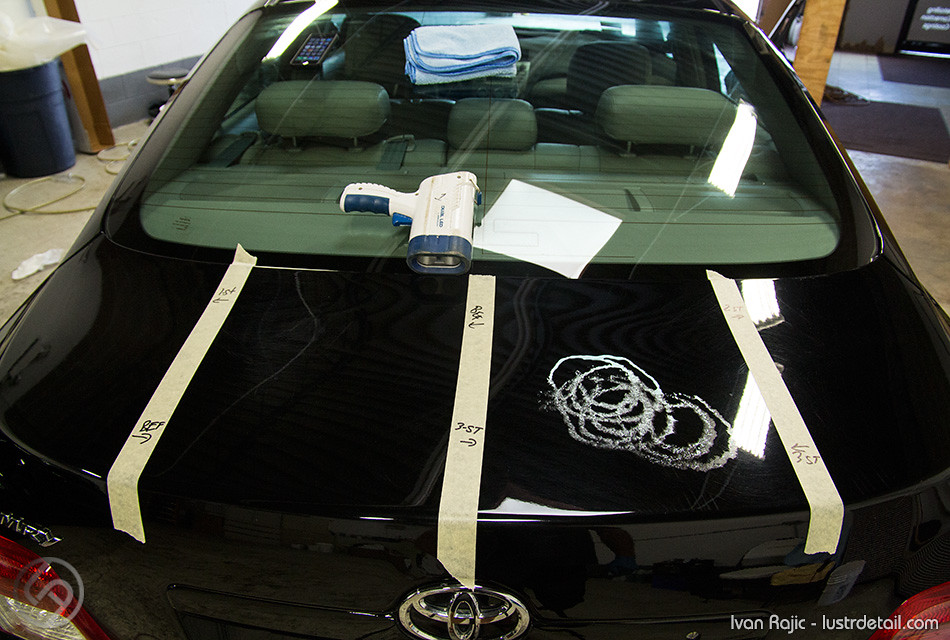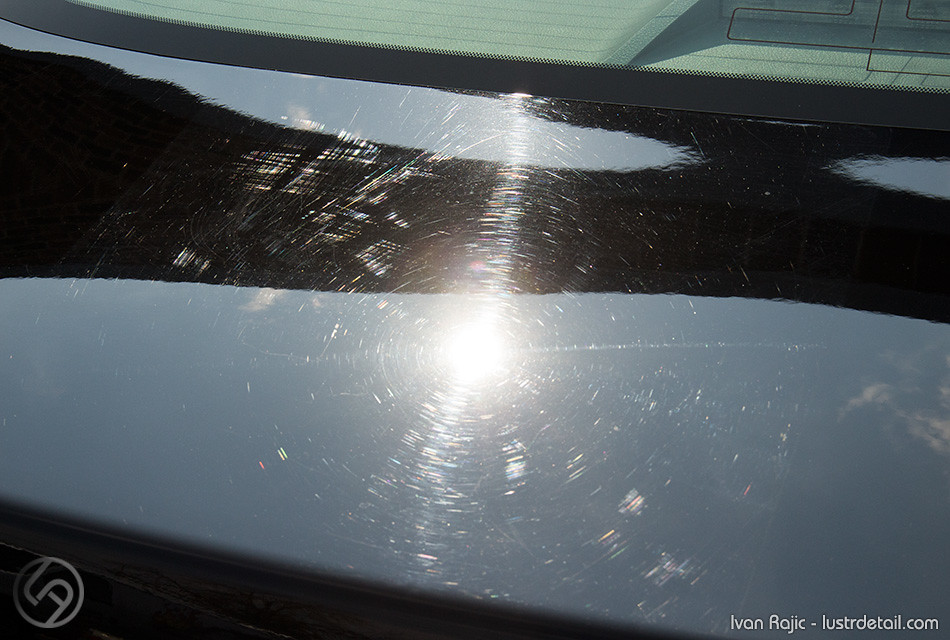We’re used to seeing a lot of great work shown on the blog with amazing before and after photos, process, etc. All of us professionals, along with many enthusiasts here enjoy bringing a paint that’s somewhat beat up “back to life”. This is done through a polishing process, which can vary greatly from person to person. There are so many different polishers, polishing pads, polishes and techniques that one can probably write a book about all of it. One thing I’ve noticed that gets discussed quite a bit after someone corrects the paint on a vehicle is the level of correction or perfection achieved, but no one really has a scale in text or images to show exactly what this means. Many times we as professionals will tell clients they can expect “75% improvement” or “95% perfection” etc. and many enthusiasts will share similar stories online, but again, there’s no set standard as to what these numbers actually mean.
I’m not here to create a standard nor to explain what the numbers mean because it is a greatly subjective topic and to different people “90% perfect” may mean very different things. However, I wanted to share the “scale” we use at LUSTR and explain at least a bit what we mean when we give out a percentage of improvement. For this, I couldn’t have asked for a better car than my friend’s 2011 Toyota Camry with jet black and fairly beat up paint.
The trunk was the test area and I divided it into 4 sections. Starting from the left, the 1st section received one stage of polishing, 2nd section was not polished and represents the before condition, 3rd section received three stages and 4th section two stages. Stage in this case means that I went over that section with one polishing cycle, with a single pad and polish.

As you can see above, I took the photo after I started to use Menzerna FG400 with a LC Purple foamed wool pad on the section receiving 3 polishing stages. I used various products and polishing steps on each section and to keep it simple, below is a list of each trunk section and the work that was done on each.
- 1st Section (1 Stage Polishing Process): Menzerna SF 4000 with LC White Pad
- 2nd Section: Nothing/before condition of paint
- 3rd Section (Three Stage Polishing Process): FG400 with LC Purple foamed wool pad as 1st stage, M105 with Orange LC pad as 2nd stage and SF 4000 with LC White Pad as 3rd stage
- 4th Section (Two Stage Polishing Process): M105 with Orange LC pad as 1st stage and SF 4000 with LC White Pad as 2nd stage
- All polishing was done with a Flex 3401 polisher
The Results:

The above image shows the before condition. As you can see, it has many swirl marks with some deeper scuffs in the upper left corner of this section.
Here’s the improvement we got from the 1-stage polishing. As you can easily tell, there’s a huge improvement in color and swirl marks, but many deeper marks still remain, as shown in the next couple of photos. I would rate this at 65-70% perfect as most or all of the light swirl marks are gone and the paint has improved from a duller, grayish color to a deep black again, with only deeper marks remaining. For this type of polishing, one should always have a few different pad and polish combinations handy so as to try and get as much correction as possible while still leaving a nice and glossy finish as shown here.
These would require a much heavier pad/polish combination to improve, which we’ll get to below…
This is the 4th section, which received 2 stages of polishing. It’s obviously MUCH better than the section with only 1 stage of polishing and it’s nearly perfect. This is what I would call 90-95%+ perfect and I’ll explain why below…
Here if you look under and around the “x” marks, you will notice some random deeper defects, which could not be removed with the 2-stage polishing.
Above is the same section just at a slightly different angle and position on the panel.
Here too I marked some deeper swirls with an X.
Here is the 3rd section that received 3 stages of correction. This I would consider 95%+ perfect because I truly believe that unless you’re dealing with a brand new car with really good paint, there will always be a random deep swirls such as the ones marked with an X above. This means that a car’s paint will rarely be perfect, but it is not impossible. On a sensitive jet black paint, it may be nearly impossible to make even perfection last more than a wash, as some of us know too well by now! Here’s another photo of the 3rd section…
And here’s why I’m not calling it perfect…
The number 1 above shows a deeper swirl mark in that 3rd section that’s nearly perfect. The reason this section is “more perfect” than that 4th section that received only 2 stages is simply because there will be more of these deeper swirl marks left over after 2 stages of polishing than with 3 stages. In the case of this trunk, I believe there were maybe 5-8 on the 4th/2-stage section and only 1-3 on the 3rd/3-stage section. For those wondering, the #2 above shows a tape line between the 3rd and 4th section, so I’m not going to hold it against either section for that deep mark :). Below is just another shot of that tape line, easily visible from a different angle of the 3rd section, which in this photo looks perfect…
Now a few photos inside the shop…
This is exactly why one should always have a few light sources available when trying to accomplish a high level of paint correction. What looks pretty good outside, in this case looks even worse inside the shop with the indirect lights. The large “light” is actually only a skylight at our shop. Above is the before section and below is the line between the before and 1-stage polishing…
You can easily tell how much darker the paint looks and when looking at this car without direct light, the difference in gloss would be much different between the two sections. The before section here actually has a coat of wax over it, so it’s as good as it can look. You can also easily see all the deeper marks left over after only 1 stage of polishing on the left side above.
Below shows the line between before and 3 stages of polishing. Here you can clearly see no deeper marks and the paint is basically black vs grey. Huge difference and as good of an improvement as we could ever expect.
Well that’s all I got for today. To summarize, I would rate the before condition as 40-50% perfect. The 1-stage polishing gave me about 70%, 2-stage roughly 90-95% and 3-stage 95%+. One thing to note is that paint sensitivity varies and the amount of correction each stage of polishing can achieve can greatly vary. For example, if the much more resistant paint on a Mercedes looked as our before section here, it may trick you into believing that you can easily correct it to near perfect in just 2 or 3 polishing stages. However, with that type of paint, you may go only from 50-55% with 1-stage and 70-80% with 2 stages. In those cases, we like to tell clients to either do a 2 or 3 stage correction (because 1-stage won’t make much of a difference) or a simple all-in-one, non-corrective polishing to amp up the gloss a bit.
Hope that helps a bit with understanding the levels of paint correction and I’ll try to do a follow up article very soon demonstrating how different paint types react to the same polishing process.
Buy Products From This Article
Purchase the products used in this article individually here!
